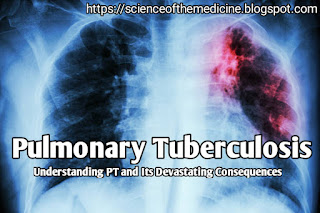Imagine waking up every morning with a persistent cough, feeling weak and fatigued, and struggling to breathe. This is the harsh reality for millions of people worldwide who suffer from pulmonary tuberculosis (TB), a deadly and highly infectious disease that affects the lungs. In this article, we'll delve into the world of pulmonary TB, exploring its causes, symptoms, diagnosis, treatment options, and the devastating consequences of this silent killer.
What is Pulmonary Tuberculosis?
Pulmonary TB is a bacterial infection caused by Mycobacterium tuberculosis, which primarily affects the lungs. The bacteria are usually spread through the air when an infected person coughs, sneezes, or talks.
Causes of Pulmonary Tuberculosis
Pulmonary TB is caused by the Mycobacterium tuberculosis bacteria, which can be spread through:
1. *Airborne transmission*: Inhaling the bacteria through the air when an infected person coughs, sneezes, or talks.
2. *Close contact*: Being in close contact with an infected person, such as living with them or sharing a room.
3. *Weakened immune system*: Having a weakened immune system, such as HIV/AIDS or taking immunosuppressive medications.
Symptoms of Pulmonary Tuberculosis
The symptoms of pulmonary TB can be mild or severe and may include:
1. *Coughing*: A persistent cough that lasts for weeks or months.
2. *Chest pain*: Chest pain or discomfort that worsens when coughing or deep breathing.
3. *Coughing up blood*: Coughing up blood or rust-colored sputum.
4. *Fatigue*: Feeling weak and fatigued.
5. *Weight loss*: Unexplained weight loss.
6. *Night sweats*: Recurring night sweats.
7. *Fever*: Recurring fever.
Diagnosis of Pulmonary Tuberculosis
Diagnosing pulmonary TB typically involves:
1. *Chest X-ray*: A chest X-ray to visualize the lungs and look for signs of TB.
2. *Sputum test*: A sputum test to collect and examine mucus from the lungs.
3. *Blood test*: A blood test to detect the presence of TB bacteria.
4. *Tuberculin skin test*: A tuberculin skin test to measure the body's response to TB bacteria.
Treatment Options for Pulmonary Tuberculosis
Treatment for pulmonary TB typically involves:
1. *Antibiotics*: A combination of antibiotics, such as isoniazid, rifampicin, and ethambutol, to kill the TB bacteria.
2. *Directly observed treatment*: Directly observed treatment, where a healthcare worker watches the patient take their medication.
3. *Hospitalization*: Hospitalization may be necessary in severe cases or for patients with weakened immune systems.
Consequences of Pulmonary Tuberculosis
Pulmonary TB can have devastating consequences if left untreated or undertreated:
1. *Death*: Pulmonary TB can be fatal if left untreated.
2. *Lung damage*: Pulmonary TB can cause permanent lung damage, leading to respiratory problems.
3. *Spread to other parts of the body*: Pulmonary TB can spread to other parts of the body, such as the brain, spine, or kidneys.
Prevention Strategies
Preventing pulmonary TB requires:
1. *Vaccination*: Getting vaccinated with the Bacille Calmette-Guérin (BCG) vaccine.
2. *Screening*: Screening for TB in high-risk populations, such as those with HIV/AIDS or close contacts of TB patients.
3. *Good hygiene practices*: Practicing good hygiene, such as covering the mouth and nose when coughing or sneezing.
Conclusion
Pulmonary TB is a deadly and highly infectious disease that affects millions of people worldwide. By understanding the causes, symptoms, diagnosis, treatment options, and consequences of pulmonary TB, we can take steps to prevent its spread and ensure prompt treatment for those affected. Remember, pulmonary TB is a curable disease if treated promptly and properly.

.jpeg)

